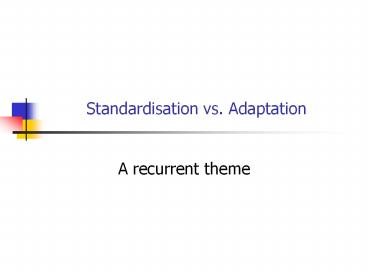Standardisation vs. Adaptation - PowerPoint PPT Presentation
1 / 24
Title:
Standardisation vs. Adaptation
Description:
Standardisation vs. Adaptation A recurrent theme Standardisation A uniform offer on a regional/global basis Minor adaptations may be made to conform to local ... – PowerPoint PPT presentation
Number of Views:862
Avg rating:3.0/5.0
Title: Standardisation vs. Adaptation
1
Standardisation vs. Adaptation
- A recurrent theme
2
Standardisation
- A uniform offer on a regional/global basis
- Minor adaptations may be made to conform to local
regulations or technical requirement (e.g.
electricity voltage) - Capitalises on commonalities in customers needs
across countries
3
Standardisation
- Usually considered in the context of
- product
- pricing
- marketing communicationsparticularly
advertising, branding, packaging
4
Standardisation
- The goal is to minimise costs
- These can be
- passed though to customers or
- taken as profit depending on the competitive
environment
5
Product standardisation
- 5 forces favouring this strategy
- common customer needs
- global customers
- economies of scale
- time to market
- regional market agreements
6
Product standardisationcommon customer needs
- The same usage and/or perceived benefits
- e.g. Convergence in the car market across Triad
markets - Functionally, towards 7-9 m2
- Psychologically, in terms of
- self-expression
- pleasantness of driving experience
- comfort
7
Product standardisationcommon customer needs
- But there can be within-region variations
- E.g. BMW research in Europe
8
BMWs European positioning
9
Product standardisationGlobal customers (MNCs)
- Result of global sourcing a characteristic of
B2B (business to business) markets - E.g. MNCs often place global contracts for the
supply of materials/components etc.
10
Product standardisationEconomies of scale
- Traditional reason for standardisation
- CAD/CAM techniques enable mass customisation and
small batch production at low cost
11
Product standardisationTime to market (e.g.
Sony case)
- Innovation alone does not always provide
competitive advantage - Speed of launch is becoming increasingly
important - E.g. PG estimate its time to market of liquid
detergents is now 10 of 1980s. - The key is centralisation
- NB Sony case - read it!
12
Product standardisationRegional market
agreements (e.g. EU)
- Encourages regional launches
- lower taxes within boundaries
- common technical standards
- Favours common brand names
- e.g. Marathon (UK) to Snickers (Cont. Euro)
- e.g. Raider Bar (Cont. Euro) to Twix (UK)
13
Product standardisation
- The issue is not either/or
- But What elements should be tailored to local
conditions?
14
The costs of standardisation
- Stifles local initiative and experimentation
- High cost of failure
15
Standardisation of the communications strategy
- 2 components
- message
- execution (visual, scripting, media
- Still relatively uncommon
- Recent examples
- AXA (insurance)
- HSBC (banking)
- BA
16
Standardisation of the communications strategy
benefits
- Savings come from economies of scale
- Provides a consistent image
- Appeals to global consumer segments
- Shortage of creative talent
- Cross fertilisation of good ideas in one market
to another - e.g. Sony
17
Standardisation of the communications strategy
benefits
- Research amongst ad agencies suggest that
- most important driver of standardised advertising
is the global brand
18
The Worlds top 20 brands -Interbrand 2006
- 1. Coca-Cola
- 2. Microsoft
- 3. IBM
- 4. GE
- 5. Intel
- 6. Nokia
- 7. Toyota
- 8. Disney
- 9. McDonalds
- 10 Mercedes-Benz
- 11. Citigroup
- 12. Marlboro
- 13. Hewlett-Packard
- 14. American Express
- 15. BMW
- 16. Gillette
- 17. Louis Vuitton
- 18. Cisco
- 19. Honda
- 20. Samsung
19
Standardisation of the communications strategy
barriers
- Cultural differences
- benefits sought (see BMW research)
20
BMWs European positioning
21
Standardisation of the communications strategy
barriers
- Usage
- Food and drink
- e.g. tea drinking
- e.g. cognac
- US stand-alone drink
- Europe after dinner drink
- China at dinner with water
- Therefore need to adapt the context to different
cultures
22
Standardisation of the communications strategy
barriers
- Cultural differences
- e.g. Hofestedes masculinity index
- PG in Japan
- showed an advert with a man walking into a
bathroom when his wife was taking a shower - shows disrespect for women e.g. in Japan
- Japan is no. 1 on masculinity index
23
Standardisation of the communications strategy
barriers
- Local advertising regulations
- e.g. in Malaysia foreign-made ads must not use
white people . - Therefore Ray-Ban were forced to shoot locally
for TV ads - Variations in PLC
- Introductory phase requires an awareness-building
campaign e.g. iced tea in Europe
24
Standardisation of the communications strategy
barriers
- Finally
- The NIH (Not Invented Here) syndrome
- de-motivating
- face resistance































